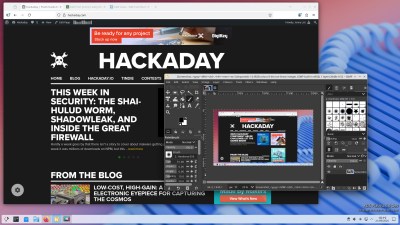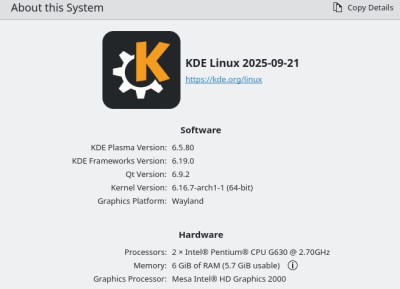 Over this series test-driving operating systems, we’ve tried to bring you the unusual, the esoteric, or the less mainstream among the world of the desktop OS. It would become very boring very quickly of we simply loaded up a succession of Linux distros, so we’ve avoided simply testing the latest Debian, or Fedora.
Over this series test-driving operating systems, we’ve tried to bring you the unusual, the esoteric, or the less mainstream among the world of the desktop OS. It would become very boring very quickly of we simply loaded up a succession of Linux distros, so we’ve avoided simply testing the latest Debian, or Fedora.
That’s not to say that there’s no space for a Linux distro on these pages if it is merited though, as for example we marked its 30th anniversary with a look at Slackware. If a distro has something interesting to offer it’s definitely worth a look, which brings us to today’s subject.
KDE Linux is an eponymous distro produced by the makers of the KDE Plasma desktop environment and associated applications, and it serves as a technical demo of what KDE can be, a reference KDE-based distribution, and an entirely new desktop Linux distribution all in one. As such, it always has the latest in all things KDE, but aside from that perhaps what makes it even more interesting is that as an entirely new distribution it has a much more modern structure than many of the ones we’re used to that have their roots in decades past. Where in a traditional distro the system is built from the ground up on install, KDE Linux is an immutable base distribution, in which successive versions are supplied as prebuilt images on which the user space is overlaid. This makes it very much worth a look.
New From The First Boot
The first thing any would-be KDE Linux user in 2025 should understand is that this bears no relation to the previous KDE Neon distro, it’s a very new distro indeed, and still at an alpha testing phase. That’s not to say it’s not very usable, but it’s worth remembering that for now it’s not something you should trust your digital existence to. Stripping away the cruft of legacy distros is evident right from the start, as even the USB installer will only boot in UEFI mode. You might be surprised how many machines try to boot external drives in BIOS mode by default, but this one requires a trip to your motherboard settings to force UEFI. The USB disk boots straight to a KDE desktop from which you can run the installer, and as you might expect, everything is graphical. That immutable base delivers probably the most hassle-free install process of any modern Linux system, and in no time you’re booting your machine into KDE Linux.

KDE is a very slick desktop, and this distro gives you the environment at its most well-oiled. I’m a GNOME user in my day to day life, but I say that not in some vi-versus-emacs sense of a software holy war; this is an environment in which everything is just right where you expect it. The sense of hitting the ground running is high here.
KDE Linux does not have a traditional package manager due to its immutable nature, but we’re told it is capable of using Arch packages. Instead of a package manager it has Discover, which handles both updates and finding applications as prepackaged Flatpaks. As someone who’s had a very bad experience with Ubuntu’s frankly awful Snap packaging, I am instinctively suspicious of packaged applications, but I have to concede the experience of using Flatpak is much less painful than the Ubuntu equivalent. I installed my usual LibreOffice and GIMP alongside Firefox, and got on with writing and editing some Hackaday.
So, What’s It Like To Use?

My test machine for this distro is not particularly quick, packing as it does a dual-core Sandy Bridge Pentium G630 and six gigabytes of memory. It’s saved from terminal sluggishness by having an SSD, but this is still decade old hardware at best. I selected it on purpose to gain a real idea of the performance; I know this machine is acceptable for day to day use running Manjaro so it gives me a good point for comparison.
Since I’ve been using it now for a few days to do my work, I guess KDE Linux makes the grade. There are none of the endless wait dialogues I got with Ubuntu Snaps on a far faster machine, and while you can certainly feel the age of the hardware at times, it’s just as usable as the native Manjaro installation on the same hardware.
You come into contact with that immutable base every time you reboot your system, as recent upgrades appear in the boot menu. If something is wrong with the latest base version then booting back into the previous one is particularly easy and seamless. The disadvantage is that you won’t have all the nuts-and-bolts configuration you are used to with more conventional distros, and some software such as older Nvidia graphics card drivers may have problems.
So in KDE Linux, there’s a new-from-the-ground-up distribution that not only has the reference implementation of KDE, but also a well-thought-out and modern structure behind it. It’s alpha software at the moment so you may not want to make the jump just yet, but it definitely doesn’t feel like an alpha. This is probably the most pain-free Linux install and user experience I have ever had. It’s a definite everyday contender, and over the last three decades I must have installed a large number of different distros. If they can keep it maintained and reach a stable version there’s no reason why this shouldn’t become one of the go-to desktop distributions, which as I see it is quite an achievement. Well done KDE!
















@Jenny, could you please share any experience working with USB devices like USB oscilloscopes/logic analysers or other devices like EEPROM writers or eg Greaseweasle , because the last time I tried to use them on an immutable linux (KDE Argon) I had a brain fsck trying to make udev work there, cheers
It’s true, I didn’t try anything like that. My daily driving involves writing for Hackaday, which is the object of these tests. I should find a few USB peripherals for future tests.
My favorite DE is KDE. I have had a good experience with KUbuntu LTS for all my desktops/servers/laptops needs. My snap experience has been ‘good’ as I don’t hardly notice any difference between native and snap apps…. That said, there are many distros to pick from if one doesn’t work for you or me. One of the best things about Linux is we can pick a DE (and/or distro) that fits our personal workflow… Whether Gnome, KDE, LXDE, Cinnamon, Mate, etc. .. or just run if from command-line and forgo a DE (like I do on my servers and SBCs) … All good.
Thx for the article. Didn’t know ‘KDE Linux’ existed. Learn something every day!
Same here, I really prefer KDE over Gnome for it’s cleaner look (without actual merits, just personal preference), have been using Kubuntu LTS for probably 10 years. I’ve avoided Snap’s, been using some flatpaks and while individual programs work fine, the configuration and interoperability is crappy (if I download a pdf in Flatpak Firefox, I get a dialog to select the program, where I have to open it with “System Default Handler” or something like that, and then I get a similar dialog where I can select Okular, and clicking links in email in Thunderbird will not open any browser, and download dialogs start in weird locations) but manageable.
I wonder if you can install KDE Linux with a Gnome desktop…
Might be an extension for it out there.
It’s different but Gnome has their own OS/Distro – https://os.gnome.org/
Thanks for this! I’m hoping openBSD makes the list :D
Color me interested, and I’ll probably check it out in a year or two once it’s ripened, but immutable OSes give me the heebie-jeebies. It seems like I always have to do some damn thing deep in linux’s guts to fix my laptop’s lid sensor or something.
Atomic distros are actually awesome.
I had Ubuntu for 8 years and from the first day not a week/month went by when I didn’t have to fix something in the “guts”. As it turned out that was mainly because: 1) Ubuntu is outdated and has poor hardware support, and 2) mutable distros deteriorate, as you install and update packages, at some point some system packages get replaced by a version that doesn’t play well with the rest of the system. After 8 years my Ubuntu was in such a bad state it was unusable and unfixable.
I switched to Bazzite last year and since day one everything’s worked perfectly and I haven’t had a single issue. As it turns out, having a single well-tested and immutable OS image is a huge benefit! And at the same time, I find that it’s not at all limiting and I can still install and do everything I need.
Everything that Windows does, Linux does it better.
“Everything that Windows does, Linux does it better.”
Yeah, thats why windows is running on 70% of the worlds desktops. and linux only accounts for 4-5% despite being available at no cost for three decades. Stick to servers, supercomputers, and smartphones thats what linux does well.
That market share did not come easy though, MS has been hard at work (especially in the 90’s / early 2000’s) to aggressively crush (or buy) any competition. Both with their OS and the Office suite.
Switching now has become more unlikely and difficult (especially on the corporate side) since everything ‘MS’ is the standard.
But if MS continues to ‘tinker’ with their OS to the point where it becomes more bloat than OS. (and has arbitrary system requirements) That might change on the home user side.
Android, team ‘half eaten fruit’ and Linux might become real contenders there.
I used Windows for decades, not by choice, but as a condition of employment.
I only use Linux now that I have the freedom not to use Windows.
“Switching now has become more unlikely and difficult (especially on the corporate side) since everything ‘MS’ is the standard.”
I would say that switching is easier than ever now, with an ever-increasing number of applications being released in Win/Mac/Linux. And when you couple that with cloud server based applications running in the browser, the operating system is almost irrelevant, as are the standard office tools.
Just consider, what format do people use when they want to publish documents on the Internet, .docx or .pdf?
Careful there. Nearly all Linux distros are also mutable. Fedora Atomic spins are not.
Exactly. Unless a person feels compelled to tinker with the inner workings of the OS file system (Who?), Fedora Atomic (or UBlue) is always the best choice.
I can see getting to a state that you can’t be bothered to fix it, however it should always be possible – starting with switching everything to the distro maintainers packages and losing anything that doesn’t have dependency met is usually the first step I’d take.
Not that I disagree with you if an immutable distro can fit your needs it is probably the most rookie/lazy user friendly
Have you used LTS or normal? LTS is usable, last time when i used Ubuntu, the non-LTS was buggy as hell.
Switched to Debian… :D
This sounds a lot like Aurora with an Arch base, and possibly more modern due to no legacy baggage. Can’t wait to try it once it graduates!
Yes, it will basically be Kinoite with an opinionated desktop and proprietary addons for developers and for device support. And that’s exactly what Aurora is. I keep hearing that Arch is less stable than Fedora but can be slightly faster for gamers. Aurora’s cousin Bazzite says, maybe, maybe not.
Well I use CachyOS with KDE Plasma 6.4.5 as a daily driver, and works fine. I think this KDE Linux is just basically like NEON a developer test bed basically but you could daily drive, but I like Cachy OS optimized for gaming.
Their intent is very explicitly different from Neon, as mentioned in the article. Neon was always a dogfooding testbed, whereas they mean for this to be the benchmark implementation for everyday use. It is in alpha, yes, but the intent is very different
Neon i felt fantastically tailored, but very buggy. So because of this :D
Thanks for introducing me to “immutable” operating systems. This may be useful for one 2011 HP notebook that stays at home and Ubuntu fails to update (I don’t have time to investigate this).
I really enjoy this series.
Then you’ll certainly enjoy: https://hackaday.com/2025/07/10/personal-reflections-on-immutable-linux/ which digs more into the whole immutability thing, and name-drops quite a few more distributions you might want to check out.
How could I miss that is beyond me. Thank you.
ditto this. Starting to explore atomic and immutability myself.
I run Fedora & KDE. Black background, no icons, menu autohide. I open Konsole and type the name of the program I want to run.
Has it ever occurred to you that KDE Plasma might be overkill for your workflow??
I try to do that, except that I do like wallpaper. I keep 3 Konsoles open at all times. I have an old version of KDE, and so much is broken. Autohide doesn’t work. “Apply initially” for “Window on top” doesn’t work. Some panel setup options lead to dead ends. I’m afraid to update lest the new version is worse.
I was delighted to find that the Meta key brings up a fullscreen transparent menu. It’s a real time saver for commands that don’t require options. Set up properly, that same Meta key can be used with the scroll wheel to zoom the whole screen.
I’ve been a user of immutable Fedora Atomic 42 almost since I first started using Linux earlier this year. Not only did I do my research, but I was already a fan of ChromeOS, which is the poster-child for the atomic OS. When F43 comes out later this year, I’ll switch from Kinoite to Budgie Atomic, which I prefer. Budgie 10.10 in F43 is the first Budgie that uses the Wayland display server. Then I’ll consider KDE Linux if it makes sense after its beta. I’m liking Plasma, but frankly, I likely wouldn’t use the things that it offers that Budgie can’t do.
So this works like in the old DOS days? Every part is one executable binary? The OS and all the apps, too? Sounds interesting.
How do you use Python in such an environment? :evilgrin:
Luddite thought: Docker, electron, and now immutable distros are just re-creating the static binary experience. What if we just admitted that hard-drive space is cheap now and turned the clock back 30 years, to the time before dynamicly loadable objects?
What would we really lose?
Disclaimer: I run DWM, actually.
Some programs, firefox for instance, use a lot of memory. Static linking means that each instance must load its entire image when it starts up, making startup slow. Suddenly my 32 Gbyte RAM seems marginal if I’m running several programs simultaneously..
Nonetheless, I suspect that static linking makes computing more robust.
No, that’s not how it works. Any fork of an existing program share the same memory pages until this particular instance needs to change it. So if you have 10 instances of a statically built Firefox, you’ll have 1 instance of the library in memory, since the library executable code is read only, it never changes. However, if you have Firefox version A and Firefox version B loaded at the same time, you’ll double the resource usage, obviously.
That’s not crazy at all. Since I started my Go journey I became more and more aware how beautiful going back to true single binaries is. Stuff just works. As a developer it is your own responsibility to make an app work, but once you are done, you are done.
Yes. It’s a waste of space, and flexibility.
KDE/Slackware linux, is the way to go. Functional and rock solid.
brian-in-ohio
Try connecting a phone.
KDE doesn’t mount MTP devices, it shows them but will only interact through its own media library.
No cli interaction, no non-KDE programs.
MTP device is not an USB storage. How could it work like one?
There are no file, no folder, only media objects in MTP.
Did you expect your computer to start copying all the pictures and video to your hard drive by itself, so your usual software can deal with them? I’m not, hopefully.
You can emulate a MTP media object as a file on Linux with some FUSE hackery, but it stays an hack, since you can’t do all the things you’re doing with file on a MTP object (like editing in place, mutability, renaming, compressing, …).
If you have someone to blame, blame Google and Apple for pushing on MTP protocol usage on Android instead of improving the USB’s storage class for partial file & folder locking. They have done it this way for 2 reasons: to make the experience of plugging your phone so miserable that their “cloud” service looks like heaven in comparison, and to mock up their device as camera devices.
More people should be angry about this. It all started when Apple’s iPod didn’t work as a generic USB Mass Storage device.
Is gvfs installed? MTP module for gvfs?